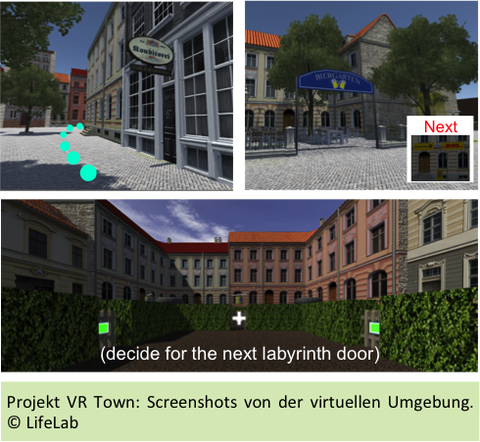Entwicklung & Navigation - NAVI
Das Projekt "Entwicklung & Navigation - NAVI" untersucht das räumliche Navigieren über die Lebensspanne
Theoretischer Hintergrund
Räumliches Navigieren, d.h. die Fähigkeit in der Umgebung bestimmte Wege oder einen noch unbekannten Zielort zu finden, ist grundlegend für Menschen aller Altersgruppen, um die Anforderungen des Alltags zu meistern. Die Fähigkeit komplexe allozentrische Repräsentationen von räumlichen Begrenzungen und Karten der Umgebung zu bilden, basiert insbesondere auf dem Hippocampus. Das Striatum ist hingegen bei der Bildung egozentrischer Stimulus-Response-Assoziationen unter Berücksichtigung räumlicher Landmarken involviert. Sowohl normales Altern als auch dopaminerge Dysregulation bei Parkinson-Erkrankung beeinflussen die Priorisierung von Navigationsstrategien. Im Gegensatz zu jungen Erwachsenen präferieren gesunde ältere Erwachsene und Parkinson-Patienten verstärkt striatale Cue-basierte anstatt hippocampal-basierte räumliche Navigationsstrategien [1-3]. Dopaminerge Medikation hat zudem einen begünstigenden Effekt auf die striatal- und hippocampal-basierte räumliche Gedächtnisleistung [3].
Das Projekt ist assoziiert mit dem DFG Sonderforschungsbereich SFB940 (www.sfb940.de) der TU Dresden (Förderperiode 1 Projekt C4, 2012-2016) und wird teilweise durch die Roland-Ernst-Stiftung für Gesundheit (Projekt Tiefenhirnstimulation, 2014-2016) gefördert (www.roland-ernst-stiftung.de).
Projektziele
- Entwicklung Virtual Reality-basierter Tests zur Untersuchung des räumlichen Gedächtnisses und Entscheidungsverhaltens (Zusammenarbeit mit dem BMBF-geförderten Konsortium TRAINSTIM).
- Untersuchung von Hippocampus- und Striatum-basiertem räumlichen Lernen und Gedächtnis über die Lebensspanne (6-80 Jahre) sowie bei Modellerkrankungen wie Parkinson-Erkrankung.
- Untersuchung der Effekte von Interventionsmethoden wie pharmakologischer Dopaminmanipulation und nicht-invasiver Hirnstimulation (Zusammenarbeit mit dem BMBF-geförderten Konsortium TRAINSTIM).
Projektleiter und Team
Prof. Shu-Chen Li, Ph.D.
Dr. Franka Thurm
Dr. Susanne Passow
Dr. Nicolas Schuck (assoziierter Beschäftigter)
Ausgewählte projektrelevante Publikationen
- Schuck, N.W., Doeller, C.F., Polk, T.A., Lindenberger, U., & Li, S.-C. (2015). Human aging alters the neural computation and representation of space. Neuroimage, 117, 141-150. doi: 10.1016/j.neuroimage.2015.05.031
- Schuck N.W., Doeller C.F., Schjeide B.M., Schröder J., Frensch P.A., Bertram L. and Li S.-C. (2013). Aging and KIBRA/WWC1 genotype affect spatial memory processes in a virtual navigation task. Hippocampus, 23(10), 919-930. doi: 10.1002/hipo.22148
- Thurm, F., Schuck, N.W., Fauser, M., Doeller, C.F., Stankevich, Y., Evens, R., Riedel, O., Storch, A., Lueken, U., & Li, S.-C. (2016). Dopamine modulation of spatial memory in Parkinson’s disease. Neurobiology of Aging, 38, 93-103. doi: 10.1016/j.neurobiolaging.2015.10.019


